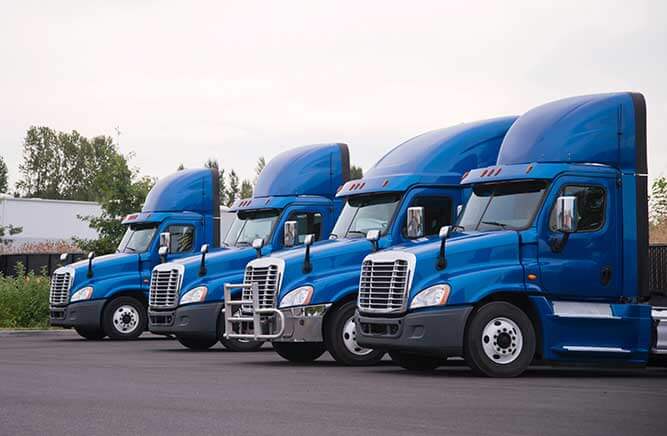Navigating Bankruptcy For Trucking Companies

Get better rates on every deal.
Rate against hundreds of thousands of daily loads and one million power units.
The last three years have been a roller coaster ride for those in the trucking industry. From historically high rates, an economic recession, and a market that feels unpredictable, there’s a real sense of concern, particularly for owner-operators.
One noticeable disruption to the industry is that some trucking companies are filing for bankruptcy. And while this only adds to the market uncertainty, bankruptcy is not always the end of the line.
We’ll take a look at types of bankruptcy for trucking companies, factors that contribute to making the decision, the bankruptcy process, and how it can sometimes be an opportunity in disguise.
Types of Bankruptcy for Trucking Companies
Bankruptcy for a trucking company occurs when an individual owner-operator or business group is unable to pay their outstanding debts or obligations and is forced to begin a legal process to pay debts to creditors. But bankruptcy doesn’t always mean you’re closing your doors and shuttering your business.
There are two types of bankruptcy for trucking companies: a Chapter 7 bankruptcy and a Chapter 11 bankruptcy. The impacts are both short- and long-term, but they can be navigated and give your business alternatives in times of struggle.
Chapter 7 bankruptcy
A Chapter 7 bankruptcy is the most common form of corporate bankruptcy. It’s also known as liquidation bankruptcy. It’s beyond the stage for reorganization, and all non-exempt assets must be sold off to pay any creditors.
At this point, it’s necessary to hire an attorney to help determine which assets are exempt and who will get paid. Anything left over will be combined to pay any other outstanding creditors, as well as the Trustee handling your case. Following a Chapter 7 bankruptcy, all debts will be gone, but credit will need to be re-established before moving forward.
The implications and consequences of a Chapter 7 bankruptcy mean that trucking companies close, all employees are let go, and the business is no longer operating. This includes any carriers or brokers associated with the business. It’s an unfortunate situation that can impact thousands of people and their hard-earned retirement or pensions.
Chapter 11 bankruptcy
A Chapter 11 bankruptcy is an opportunity to reorganize debts. Often, this means loans and terms will be adjusted, and the corporate structure of the company will be reevaluated.
To qualify for Chapter 11 bankruptcy as a smaller trucking business with 1 to 6 trucks, you must meet the Small Business Administration’s (SBA) criteria for being a small business, which means either having an annual revenue between $1 and $40 million or employing fewer than 1,500 individuals. Once you’ve established your small business status, you will need the assistance of a lawyer to present your case to the court, demonstrating your ability to restructure your business in order to cover outstanding debts and expenses. A crucial aspect of this procedure involves creating a detailed plan outlining how creditors will be repaid after the business undergoes restructuring. It’s important to note that this is a complex and time-consuming process that may necessitate additional financial resources, possibly increasing the business’s overall debt to hire experts who can guide you through the legal aspects.
Chapter 11 bankruptcy is usually preferred by business owners since it presents a second chance at their business. A well-planned Chapter 11 can save a fleet, which helps keep people employed and the business running.
Many companies may find the challenges associated with Chapter 11 bankruptcy to be daunting. Completely overhauling a business structure, enforcing a strict budget, extending contract payment terms, and the risk of vendors seeking contracts with other businesses may be more than some want to endure. However, success in Chapter 11 bankruptcy hinges on effective communication and meticulous organizational efforts–and can prove to be a lucrative option in the long run.
Factors that contribute to bankruptcy for trucking companies
There’s no easy way to pinpoint exactly how bankruptcy rears its head in the trucking industry. Every case is different and presents its own unique challenges. That being said, there are four main factors that contribute to bankruptcy in the trucking industry. Understanding each one can help prevent, or at least limit, their impact on your business.
- Economic downturns and market volatility. Market volatility often feels like chaos for trucking companies. Recently, the COVID-19 pandemic, the war in Ukraine, and elections have made economic forecasts unpredictable. It’s important to plan to ride the waves and be prepared for the good—and the bad.
- Rising fuel costs and operating expenses. Operating expenses can consume you if you’re not careful, and the rising fuel prices are just one contributing factor (though a big one, as it makes up over 20 percent of operating costs). The American Trucking Research Institute (ATRI) reported that the cost of trucking increased to $1.855 per mile in 2021, and that by the end of 2023, it will be around $1.88. With the help of careful planning and technology, there are ways to create operational efficiencies that will help you control expenses in trucking and keep your business moving.
- Regulatory changes and compliance issues. Regulatory changes happen every year, and 10 unique compliance laws that every trucking company needs to understand to make sure they are up-to-date. If found to be operating out of compliance, companies could be hit with hefty fines that are difficult to recover from. Your reputation matters, and building and maintaining trust increases leads and connections with carriers and shippers.
- Inefficient operations and overhead costs/mismanaged finances. Someone who isn’t business savvy can find themselves in a deep hole of debt quickly. Inefficient operations, high overhead costs, and mismanaged finances can take day-to-day hits, eventually wearing a business down to the nubs.
Bankruptcy Filing Process
While each type of bankruptcy (Chapter 7 and Chapter 11) has its own unique processes, the basic overview is incredibly similar. According to UScourts.gov, this is a basic timeline for a Chapter 7 bankruptcy process (it should be noted that all of these terms should be explained to you by your attorney):
- Day 1: File a bankruptcy petition with the court and pay the filing fee.
- Day 1–14: File Certificate of Credit Counseling, lists, schedules, statements, and payment advice.
- Day 13–33: Provide tax returns to the trustee.
- Day 20–30: Fine statement of intention.
- Day 20–40: Meeting of creditors (also called a 341(a) meeting).
- Day 50–70: Perform statement of intention.
- Day 80–100: Complete the financial management training course and file form 423. And reaffirmation agreements.
- Around day 100: Discharge granted.
A Second Chance at Business
Experience shows it is possible to come back from filing bankruptcy with a successful business, especially if mistakes from the past are corrected. In 2016, the California-based company Pacific 9 Transportation filed for Chapter 11 bankruptcy, which resulted in tens of millions of dollars in liabilities. During that time, with the advice of their attorneys, the Pacific 9 changed its model from owner-operator to employee drivers. As of 2021, Pacific 9 was running successfully, with over 100 drivers.
There are key strategies to turning your company around after bankruptcy, and though they will take a lot of work, they are all manageable. These include:
- Financial and operational restructuring. Hiring an accountant or implementing accounting software can help keep business on track. While it might feel like an extra expense, the peace of mind of having people and/or tools to accurately track spending can help avoid trouble in the future.
- Negotiating with creditors and suppliers. An attorney can negotiate rates and payment plans with creditors so payments are made on time and in full every month. Working with suppliers to be sure a payment plan is in place is also advantageous.
- Improving fleet efficiency and maintenance. Improving operational efficiency is a great way to cut costs and increase profitability. Keeping fuel consumption, truck maintenance, time management, and fraud protection front and center will directly affect your bottom line.
- Embracing technology and automation. Use technology to your advantage. Upgrade where you can, whether it’s in Transportation Management Systems (TMS), utilizing load boards more effectively, or even the technology you use to track your expenses.
Bankruptcy is a tough situation. And while it can truly be the end of the road for some, other times, it’s like hitting a reset button. Rebuilding takes restructuring, perseverance, and resilience—all of which the trucking community is known for. It’s a hard lesson but is not uncommon and the only option some companies have to survive an uncertain economy.
Get helpful content delivered to your inbox.
Sign up today.
Find high-quality loads fast, get higher rates on every haul, and access tools that make your job easier at every turn.






